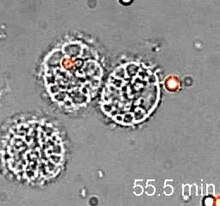Alveolar macrophage
The alveolar macrophages come on the surface of the so-called "dust cells" alveoli before (alveoli). They phagocytize dead material, toxins from the blood and foreign particles (→ pneumoconiosis ). They also produce cytokines . Alveolar macrophages originate from monocytes in the bone marrow , migrate into the lungs via the blood vessels and adhere to the endothelium of the pulmonary capillaries. When foreign particles appear, they migrate into the alveoli.
"Heart defect cells" ( siderophages ) are a special form of alveolar macrophages, which (pathologically) phagocytosed and digested red blood cells that had leaked out. The iron of the absorbed hemoglobin is visible as a yellow-brown pigment ( hemosiderin ) in the cells and can be selectively displayed with the Berlin blue color. Heart failure cells occur in left heart failure as a result of the backlog of blood in the lungs and can be detected in the sputum of the patient.
The differential cytology of bronchoalveolar lavage usually shows over 90% alveolar macrophages.
literature
- C. Kortsik among other things: Basics of cytopathology: short textbook and atlas of general and special cytodiagnostics . Karger Publishers 2002, ISBN 9783805572552 , p. 70.
